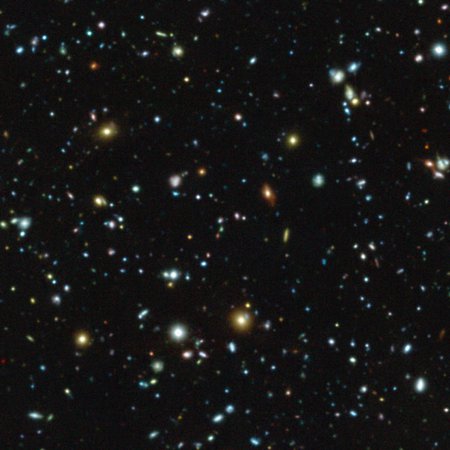Stars and galaxies with MUSE - extra clear

The Planetary Nebula NGC 6369 in the constellation Ophiochus, observed under normal conditions (left) and with the adaptive optics (right), which compensates for the atmospheric turbulence near the ground.
Credit: ESO / P. Weilbacher (AIP)Spectacular improvement of astronomical observations with MUSE using adaptive optics. Astronomers have been observing distant galaxies and nebulae with unprecedented quality using the MUSE instrument at the European Southern Observatory (ESO). This was made possible by commissioning of a new adaptive optics facility at the Very Large Telescope (VLT) in the Chilean Atacama desert.
The novel adaptive optics facility (AOF) developed by ESO has been tested for the first time with the MUSE instrument. The Multi Unit Spectroscopic Explorer (MUSE) itself is a complex 3D spectrograph that can simultaneously record thousands of spectra of entire regions on the sky and reconstruct images from this data. Scientists from the Leibniz-Institute for Astrophysics Potsdam (AIP) took part in the development of MUSE and the commissioning of the adaptive optics mode. The overall lead of the project is at the Observatoire de Lyon (CRAL) and at ESO.
Andreas Kelz, the local project manager at the AIP, explains: "Astronomical images, taken with ground-based telescopes are always slightly blurred because turbulence in the air distorts the light and thus the resulting image. With the adaptive optics enabled, most of the atmospheric turbulence can be compensated. This stabilizes and sharpens the image and more details become visible." Peter Weilbacher, a scientist at AIP who was involved in the first observations with MUSE and its adaptive optics, is impressed with the results he obtained: "We have observed different objects in the southern sky and the improvement of the image quality is spectacular. Around the Planetary Nebula IC 4406 in the constellation of Lupus, shell structures could be observed which were not visible before."
What sounds so simple is based on one of the most advanced technology that has been put into practice for the first time on the Very Large Telescope. The adaptive optics facility (AOF) of ESO consists of three systems: Four high-power lasers illuminate layers of the Earth's atmosphere at an altitude of 80 km, stimulating sodium atoms to glow, thus projecting "artificial stars" into the night sky. Sensors in the GALACSI (Ground Atmospheric Layer Adaptive Corrector for Spectroscopic Imaging) module use these artificial laser stars to measure the atmospheric turbulence. Finally, the calculated corrections are sent to a one meter large deformable mirror at the telescope. Its curvature is slightly adjusted several hundred times per second which compensates the blurring effect.
These corrections provide two essential advantages for astronomical observations: with the increased image sharpness, extended structures are depicted in much more detail. Moreover, cosmic objects that are very faint become detectable at all. "One of our key scientific projects is the observation of distant galaxies that have emitted their light over 10 billion years ago. These objects appear so small and faint that long exposure times with stable conditions are required. With the support of the adaptive optics, this can be achieved much better now." says Lutz Wisotzki, program scientist of MUSE at the AIP. "The first results with the adaptive optics for MUSE fulfil the high expectations." Kelz is delighted. The scientists at the AIP are now looking forward to further astronomical discoveries in the coming years.
The German MUSE partners from the astrophysical institutes in Potsdam (AIP) and Göttingen (IAG) are supported by the Federal Ministry of Education and Research (BMBF).
Further information
Further information:
ESO press release including pictures: https://www.eso.org/public/news/eso1724/
MUSE website at AIP:
http://www.aip.de/de/forschung/research-area-drt/development-of-research-technology-and-infrastructure-1/3d-spectroscopy/muse/development-of-the-muse-integral-field-spectrograph
Virtual Reality Tour of the VLT Observatorium: https://vr.aip.de/aipvr.html?s=pano1870
MUSE Homepage: http://muse-vlt.eu/science/
MUSE is a joint project of seven European Research Institutes,
led by the Centre de Recherche Astrophysique de Lyon (CRAL, France),
the Leibniz-Institut für Astrophysik Potsdam (AIP, Germany),
the Institut für Astrophysik der Universität Göttingen (IAG, Germany),
the Institut de Recherche en Astrophysique et Planétologie (IRAP, France),
the Sternwarte Leiden and the Niederländischen Forschungsakademie für Astronomie (NOVA, Netherlands),
the Institut für Astronomie der Eidgenössischen Technischen Hochschule Zürich (ETH, Switzerland) and
the European Southern Observatory (ESO).
Scientific contacts:
Dr. Andreas Kelz, 0331 7499-640, akelz@aip.de
Dr. Peter Weilbacher, 0331 7499-667, pweilbacher@aip.de
Prof. Dr. Lutz Wisotzki, 0331 7499-532, lwisotzki@aip.de
Images
The Planetary Nebula NGC 6369 in the constellation Ophiochus, observed under normal conditions (left) and with the adaptive optics (right), which compensates for the atmospheric turbulence near the ground.
Big screen size [1000 x 541, 70 KB]
Original size [1280 x 693, 100 KB]
NGC 6563 is a planetary nebula in the constellation Sagittarius. The impressive image was reconstructed from the MUSE data cubes using the data reduction software developed by AIP. Through the support of the adaptive optics, weak structures in the nebula are being recognized, which were not visible before. The image on the left was taken without using adaptive optics and the one on the right was made using adaptive optics.
Big screen size [1000 x 541, 70 KB]
Original size [1359 x 736, 110 KB]
ESO 338-IG04 is a starburst galaxy in the constellation Sagittarius, which is likely triggered by merging events. The new data from MUSE with the adaptive optics clearly reveal different bright knots, which mark the places of intense star formation. Luminous, hot hydrogen gas forms he filamentary structures in the outer areas.
The laser system in operation at the European Southern Observatory during the first observations with the AOF-assisted MUSE instrument. The adaptive optics partly compensates for the turbulence of the air and enables sharper images of astronomical targets. The stars of the Milky Way stretch over the observatory in the Chilean Atacama desert.
Big screen size [1000 x 663, 110 KB]
Original size [3568 x 2368, 1.2 MB]






